英语写作基础教程2第二次课教案
英语基础模块2 学生用书教案B2U4P2 Reading and Writing (1)

types of volunteers
(1) general volunteers (2) professional volunteers (2) hear from sb.
you?
1.Ss answer the question:
通过回答志愿活动的意义, 正确回答问题并熟悉
What is volunteering?
精 确 定 位 not only…but not only…but also…的
T explains the structure of the also…的结构,通过讲解其 基本用法。
总结归纳的能力。
people willing to do volunteer
work?
(2)What social skills can you
practice and develop by
volunteering?
(3) Is volunteer work an
unforgettable life experience for
4. Careful reading: Ss read the 通过自主阅读和回答问题, 自主阅读文章,正确回
text carefully and answer the 引导学生深入分析细节信 答所给问题。
three questions:
息,提升独立思辨的意识和
(1) Why are more and more
1. 能运用略读、扫读等阅读策略获取志愿活动的主旨和细节信息。 教学重点
2. 能够谈论自己所能参加的志愿活动及其意义;掌握语法结构 not only … but also …。 1. 能运用思维导图,整合、归纳文章的基本信息。 教学难点 2. 能谈论个人所能参加志愿活动的内容及其意义。 教学方法 小组讨论法、任务教学法 教学手段 PPT 课件、多媒体设备、音视频素材等
英语基础模块2 学生用书教案B2U8P3 Reading and Writing(2)
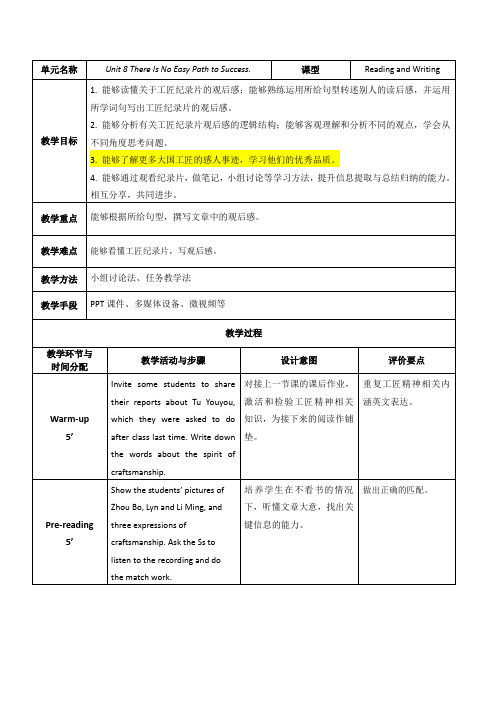
Unit 8 There Is No Easy Path to Success.
课型
Reading and Writing
教学目标
1. 能够读懂关于工匠纪录片的观后感;能够熟练运用所给句型转述别人的读后感,并运用 所学词句写出工匠纪录片的观后感。 2. 能够分析有关工匠纪录片观后感的逻辑结构;能够客观理解和分析不同的观点,学会从 不同角度思考问题。 3. 能够了解更多大国工匠的感人事迹,学习他们的优秀品质。 4. 能够通过观看纪录片,做笔记,小组讨论等学习方法,提升信息提取与总结归纳的能力。 相互分享,共同进步。
according to the information in 完整的句子,提高学生的书面 正 确 转 述周 波等 三人
the above form, using the 表达能力,为活动五作铺垫。 的观后感。
following sentence patterns: _____ watched the documentary about ______________. What impressed him/her most was _________________________ _.
More than 20 years
Not work but his life.
an old building restorer She created a new method, which
combined the ancient skills and
modern technologies.
A craftsman of
教学重点 能够根据所给句型,撰写文章中的观后感。
教学难点 能够看懂工匠纪录片,写观后感。
教学方法 小组讨论法、任务教学法 教学手段 PPT 课件、多媒体设备、微视频等
作文第二课时教学设计

作文第二课时教学设计英文回答:Instructional Design for the Second Lesson of Composition.Learning Objective:Students will be able to demonstrate their understanding of the writing process by completing a writing assignment.Materials:Writing assignment.Writing utensils.Paper.Procedure:1. Begin by reviewing the writing assignment with students. Make sure they understand the topic and the requirements.2. Allow students to begin writing. Encourage them to use the writing process to plan, draft, revise, and edit their work.3. Provide feedback to students as they work. This feedback can be given individually or in small groups.4. Have students share their work with the class. This can be done through presentations, peer review, or other methods.5. Conclude the lesson by summarizing the writing process and reviewing the writing assignment.Assessment:Students will be assessed on their ability to complete the writing assignment according to the requirements. The assessment will also include the student's ability to usethe writing process effectively.Differentiation:For students who need additional support, provide them with a scaffold or template to help them with their writing. For students who are advanced, challenge them with a more difficult writing assignment or ask them to complete additional writing tasks.Extension Activities:Have students publish their work in a class anthologyor online.Have students participate in a writing workshop or conference.Have students research different writing styles andtechniques.中文回答:作文第二课时教学设计。
英语基础模块2 学生用书教案B2U3P2 Reading and Writing (1)

Post-reading
15’
1.Ssthink about the question: how to make suggestions in guidelines. T introduces examples ofimperative sentences used inthesuggestions.
B.What do you advise them to do?
通过图片让学生了解文章的主题,初步认识意外受伤的概念与种类,为进一步阅读做好铺垫。
识别各种意外受伤的正确表达,简单表达处理的建议。
2.T shows the guidelinein ActivityOneand asksSsto think about the questions:
Homework:Ssimprove their guidelines about handling a sprained ankle and make a leaflet with texts and pictures.
梳理所学内容,反思阅读策略,回顾语言知识中的重难点,总结急救处理指南的词汇结构特点,以读促写,培养学生综合语言实践的能力。
单元名称
Unit 3I’veGot a Headache
课型
Reading and Writing
教学目标
1.能够正确理解与意外受伤处理相关的急救指南,掌握有关急救用品的词汇,并口头分享急救常识。
2.能够分析与介绍急救步骤相关说明文的逻辑结构和语言特点,能够联系自身实际,分享个人经历与体会,实现知识和思维能力的迁移。
利用图片信息,帮助学生运用所学词汇结构与表达方式进行情境迁移,为下一步解决实际问题做准备。
《英语写作二》课程教学大纲

《英语写作(二)》课程教学大纲一、课程基本信息英文名称ENGLISH WRITING II课程代码课程性质必修课授课对象大学英语新生(医学院)学分2学时34主讲教师主讲教师修订日期2021年3月指定教材《新世纪大学英语系列教材(第二版)写作教程2》(刘海平主编)、上海外语教育出版社;美国大学英语写作(第九版)Writing Skills With Readings (Ninth Edition)二、课程目标(一)总体目标:The first semester foundation skills academic writing course (Writing 1 syllabus) ends with students focusing on writing a well-structured persuasive argument, while avoiding generality, triviality and redundancy, with complex sentences, high idea density, and statements evidenced in the students’ own words.As a natural progression, this second semester syllabus is designed to extend students understanding and practice of academic writing features, by means of an investigative research project as a term-long writing task. Ideally, this syllabus would be taught in the student's sophomore year, but that is not currently an option. In addition, should there be three semesters of academic writing, the current Writing 1 and 2 syllabus can supplemented by this author's Writing 1.5 syllabus, which is focused on extensive critical analysis in reading for responding in writing.(二)课程目标:The Writing 2 syllabus term-task is mainly divided into a simple research proposal document followed by a paper with four sections, with one formative and one summative assessment of each section. Students learn how to research and write in English, a simple structured investigative literature-based paper of about 3,000 words, on a specific topic that is different from classmates and from the previous year's students, that is closely related to their major.Within the course, students are expected to learn functional language for research writing, such as tentative and connector phrases, as well as the key purposes, structures and typical content of each section of the paper. Other abilities expected to be evidenced are describing diagrams and charts, citing sources, paraphrasing and avoiding plagiarism. The processes students undertake incorporate multiple self, peer and tutor-led reflection on assignment stages, applying criticalthinking and structured argument, and are intended to promote further improvement of objectivity, accuracy, complexity and significance in students' writing.课程目标1:Conforming to an accepted academic research paper format (MLA) and elements (parts, sequence, logical argument, significance, etc.).Developing skills in sourcing and reading English language academic articles and subsequent note making for writing and referencing purposes.课程目标2:Conforming to an accepted academic research paper format (MLA) and elements (parts, sequence, logical argument, significance, etc.).Developing skills in sourcing and reading English language academic articles and subsequent note making for writing and referencing purposes.课程目标3:Conforming to an accepted academic research paper format (MLA) and elements (parts, sequence, logical argument, significance, etc.).Developing skills in sourcing and reading English language academic articles and subsequent note making for writing and referencing purposes.课程目标4:Outlining,drafting, self-review and developing learner autonomy, whilst incorporating feedback from peers and instructor.Reflecting on a term long writing project experience.课程目标5:(三)课程目标与毕业要求、课程内容的对应关系表1:课程目标与课程内容、毕业要求的对应关系表课程目标对应课程内容对应毕业要求课程目标1Critical note making:200 word - Notes for researchfield and specific topic talk;Specific topic and research gapjustification statementOver the semester, studentswrite a research paper ofabout 3000 words.课程目标2Writing a Literature Review:This is a specificinvestigation that is related400 word - Introduction section (including method and RQs) 1st submission.to the student's major (with four main sections; Introduction, Literature Review, Discussion and Conclusion).课程目标3Advanced critical writing skills:600 word - Literature Reviewsection 1st submission Week11Midterm Test - 1500 wordsHalf-paper (From cover page toend of Literature Review)It can be experiment based,but is more likely to beliterature based. Beforecommencing on the mainproject, a research proposaldocument needs approvalfrom the instructor.课程目标4Proofreading the entire paper:Submission of complete 3000word research paper (cover,contents, figures, Introduction(method, RQs), LiteratureReview, Discussion, Conclusionand List of References)Students undertakeincorporate multiple self,peer and tutor-led reflectionon assignment stages,applying critical thinkingand structured argument, andare intended to promotefurther improvement ofobjectivity, accuracy,complexity and significancein students' writing.三、教学内容第一单元:Critical note making1.教学目标:Introduction to instructor, course and scientific research writing (ppt). Model research paper. Review of previous semester's writing skills, initial researching, topic talk note making, four parts to justifying a research topic and interrogating a topic statement model.2.教学重难点:Four parts to justifying a research topic and interrogating a topic statement model.3.教学内容:Syllabus and assignments stages, due dates and basic criteria. Narrowing and critiquing a topic, forming meaningful RQs, critical note making, turning a topic talk into a research proposal (modeled on ppt). How to write an Introduction section (part4.教学方法Interaction and inspiration between Teacher and Students5.教学评价Comments on excellent model students' classroom participation; pay attention to the evaluation of students' innovation ability, critical thinking ability第二单元:Writing a Literature Review1.教学目标:How to write a Introduction section (part 2), without information gaps. Introduction section writing tutorial. Method sub-section writing. Approval and advising on submitted research proposals.2.教学重难点:Approval and advising on submitted research proposals.3.教学内容:Tutorial class to self and peer improve Introduction, using worksheets and class / one to one discussions;Advanced critical writing skills; analyzing argument (structure consistency/validity/assumption/etc.) Various written tasks to prove understanding of key elements of critical reading for discussion writing4.教学方法Interaction and inspiration between Teacher and Students5. 教学评价Comments on excellent model students' classroom participation; pay attention to the evaluation of students' innovation ability, critical thinking ability第三单元:Advanced critical writing skills1.教学目标:Writing a Literature Review. Model LR's. Structural organization choices. Language tocompare/contrast/differentiate researched sources. Organizing sources. Searching online.Avoiding citing Wikipedia. Plagiarism. Elements of discussion writing, Findings / Discussion writing, group discussions models, model interrogation worksheet and outline worksheet.2.教学重难点:Searching online. Avoiding citing Wikipedia. Plagiarism3.教学内容:Diagrams. Working with data. Language for describing experiments/ charts / diagrams, etc.Tutorial class for writing a Literature Review section. Tutorial class for writing a Discussion section.Writing propositions, supporting arguments, intermediate, summative and logicalconclusions, writing limitations, improving titles. Model Conclusion.Elements of discussion writing, Findings / Discussion writing, group discussions models, model interrogation worksheet and outline worksheet.4.教学方法Interaction and inspiration between Teacher and Students5. 教学评价Comments on excellent model students' classroom participation; pay attention to the evaluation of students' innovation ability, critical thinking ability第四单元:Proofreading the entire paper1.教学目标:Self and peer review worksheets for checking Literature Review quality. Problem solving class discussion. Tutorial class on writing a conclusion section. Self and peer reviewworksheets. Writing the List of References section and Abstract.2.教学重难点:Problem solving class discussion. One-to-one interviews, aimed at improving each student's final paper.3.教学内容:A.Class and individual discussions of returned Literature Reviews. Reviewing half-paper requirements tutorial.B.Reviewing, improving and proofreading the entire paper.C.Week 17. Final Exam - Full paper submission. Submitting a no plagiarism declaration. Prompts for writing a course reflection and learning progress essay4.教学方法Interaction and inspiration between Teacher and Students5. 教学评价Comments on excellent model students' classroom participation; pay attention to the evaluation of students' innovation ability, critical thinking ability四、学时分配表2:各章节的具体内容和学时分配表章节章节内容学时第一单元Critical note making8第二单元Writing a Literature Review8第三单元Advanced critical writing skills8第四单元Proofreading the entire paper10五、教学进度表3:教学进度表周次日期章节名称内容提要授课时数作业及要求备注1-4 3.8-3.291Critical note making8Written submission5-8 4.5-4.262Writing a Literature Review8Written submission9-12 5.3-5.243Advanced critical writing skills8Written submission13-175.31-6.284Proofreading the entire paper10Writtensubmission 六、教材及参考书目1. Science Research Writing - A Guide for Non-native Speakers, H. Glasman-Deal, Imperial College Press, 20102. The St. Martin's Handbook, 7th Edition, A.L. Lunsford,Bedford/St. Martins 2011.七、教学方法Teaching methods are based on TBLT but with earlier setting of the ultimate production goal. Most lessons begin with showing clear lesson goals, followed by raising interest, after which key functional knowledge is provided by ppt, supported by handout model texts, stage tasks and group and class discussion. Most lessons end with reviewing whether each student feels they have met the intended learning goals, before a homework assignment is issued, to confirm such learning.In the first half of the course, most of the course input is by ppt, teacher explanation, discussion, model texts and worksheets. Handouts with enhanced text and side notes of key features are used throughout, to foster greater interaction with input. In class worksheets were used to ensure students interrogated model texts. Extensive blackboard presentation is used as a summary device and to aid in providing flexible input that can respond quickly to apparent student problems.In the second half of the course, in-class tutorial time is increasingly introduced, as well as one-to-one discussions and voluntarily out of class ‘clinic’ times. Students are encouraged to start researching early and to keep a structured research notebook from the course beginning. Incidentally, classroom rules, such as no sleeping, messaging or doing other subject work, are made clear on day one and firmly enforced throughout the course. Students bring their laptop to each class, with use only allowed outside teacher presentation times.Instruments include: a review worksheet of writing 1 syllabus's key points, which is followed by weekly input via presentations, worksheets for students to interrogate models, open class analysis of model texts, worksheets to structure students thinking, planning and writing, worksheets to support self and peer review, class questions and discussions, one-to-one tutorials, online and after class additional support, explicit coded and strategic formative assessments, summative assessments by classwork and extended project exams. Finally students are guided to complete a reflection of learning and of the course inputs and goals.Key classroom strategies include close monitoring of student participation in the staged tasks by moving around the classroom, asking and answering student questions during tutorial times, and by formative assessment of tasks.表4:课程考核与课程目标的对应关系课程目标考核要点考核方式课程目标1Critical note making closed课程目标2Writing a Literature Review closed课程目标3Advanced critical writingskillsclosed课程目标4Proofreading the entirepaperclosed1.评定方法平时成绩:30%,期中考试:20%,期末考试50%2.课程目标的考核占比与达成度分析表5:课程目标的考核占比与达成度分析表考核占比课程目标平时期中期末总评达成度课程目标15%5%10%课程目标25%5%10%课程目标310%5%10%课程目标410%5%20%100%分目标达成度={0.3x平时分目标成绩+0.2x期中分目标成绩+0.5x期末分目标成绩}/分目标总分评分标准90-10080-8970-7960-69<60Very GoodGood Average Poor Very Poor课程目标AB C D F 课程目标1/2/3/4See belowSee belowSee belowSee belowSee belowExtension materialsThe extension materials that are out with the course textbooks are primarily the aforementioned presentations, model texts, worksheets for students to interrogate models, worksheets to structure students thinking, planning and writing, and worksheets to support self and peer review.。
Unit2写作课教案高中英语人教版(2)
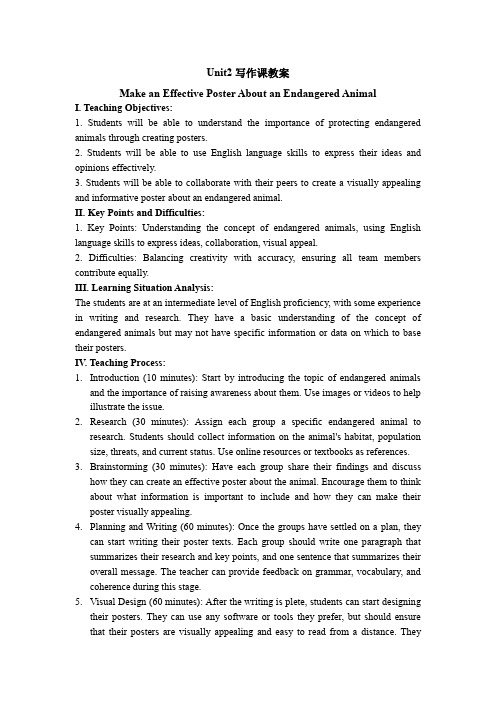
Unit2写作课教案Make an Effective Poster About an Endangered AnimalI. Teaching Objectives:1. Students will be able to understand the importance of protecting endangered animals through creating posters.2. Students will be able to use English language skills to express their ideas and opinions effectively.3. Students will be able to collaborate with their peers to create a visually appealing and informative poster about an endangered animal.II. Key Points and Difficulties:1. Key Points: Understanding the concept of endangered animals, using English language skills to express ideas, collaboration, visual appeal.2. Difficulties: Balancing creativity with accuracy, ensuring all team members contribute equally.III. Learning Situation Analysis:The students are at an intermediate level of English proficiency, with some experience in writing and research. They have a basic understanding of the concept of endangered animals but may not have specific information or data on which to base their posters.IV. Teaching Process:1.Introduction (10 minutes): Start by introducing the topic of endangered animalsand the importance of raising awareness about them. Use images or videos to help illustrate the issue.2.Research (30 minutes): Assign each group a specific endangered animal toresearch. Students should collect information on the animal's habitat, population size, threats, and current status. Use online resources or textbooks as references. 3.Brainstorming (30 minutes): Have each group share their findings and discusshow they can create an effective poster about the animal. Encourage them to think about what information is important to include and how they can make their poster visually appealing.4.Planning and Writing (60 minutes): Once the groups have settled on a plan, theycan start writing their poster texts. Each group should write one paragraph that summarizes their research and key points, and one sentence that summarizes their overall message. The teacher can provide feedback on grammar, vocabulary, and coherence during this stage.5.Visual Design (60 minutes): After the writing is plete, students can start designingtheir posters. They can use any software or tools they prefer, but should ensure that their posters are visually appealing and easy to read from a distance. Theyshould also include any relevant images or graphics that support their message. 6.Presentation (30 minutes): Each group will present their poster to the class andexplain their research, design choices, and message. The teacher can provide feedback on presentation skills and the effectiveness of their posters.7.Homework: Students will be asked to create a short video explaining their poster'smessage in English, using the same format as their written poster. They should also prepare a short summary of their research and design process for their teacher's review.V. Teaching Aids:1. PowerPoint presentation showing different endangered animals and their current statuses.2. Online resources such as websites or articles about endangered animals for research purposes.3. Textbooks or academic papers on the topic of endangered animals for additional reading material.4. Software or tools for poster design, such as Canva or Microsoft Publisher.5. Video editing software for creating the short video summaries for homework assignments.。
英语二作文指导教案模板

英语二作文指导教案模板Title: A Guide to Writing English Composition II Lesson Plan Template。
Introduction:Engaging students in the art of composition writing is crucial for their language development and criticalthinking skills. English Composition II delves deeper into various writing styles and techniques, nurturing students' ability to express themselves effectively in English. This lesson plan template aims to provide a structured approach to teaching English Composition II, incorporating elements from popular online resources while emphasizing creativity and critical analysis.Objectives:1. To familiarize students with the components of a well-structured English composition.2. To develop students' ability to analyze andinterpret essay prompts effectively.3. To enhance students' vocabulary and grammar usage in written expression.4. To encourage creativity and originality in writing compositions.5. To provide constructive feedback and guidance for improvement.Materials Needed:1. Sample English Composition II prompts。
英语二作文指导教案范文

英语二作文指导教案范文Title: Guided Lesson Plan and Sample Essay for English Writing II。
---。
Objective: To guide students in crafting a well-structured English Writing II essay.Target Grade Level: English Writing II。
Duration: 2 class periods。
Materials Needed:Writing materials (notebooks, pens)。
Sample essay prompt (provided by the instructor)。
Procedure:1. Introduction (10 minutes):Begin by discussing the characteristics of a successful English Writing II essay. Emphasize clarity, coherence, organization, grammar, and vocabulary.Introduce the sample essay prompt without revealing the specific content.2. Pre-Writing Activities (20 minutes):Brainstorming: Encourage students to jot down ideas related to the prompt.Outline: Guide students in creating an outline for their essays, including an introduction, body paragraphs, and a conclusion.3. Writing the Essay (60 minutes):Instruct students to write their essays followingthe outline they created.Encourage them to focus on expressing their ideas clearly and coherently.4. Peer Review (20 minutes):Pair students up and have them exchange essays for peer review.Provide guidelines for constructive feedback, focusing on strengths and areas for improvement.5. Revision (20 minutes):Based on peer feedback, instruct students to revise their essays, paying attention to grammar, vocabulary choice, and overall clarity.6. Conclusion (10 minutes):Recap the key points discussed during the lesson.Encourage students to continue practicing their writing skills outside of class.---。
Unit2写作课教学设计2023-2024学年人教版八年级英语下册
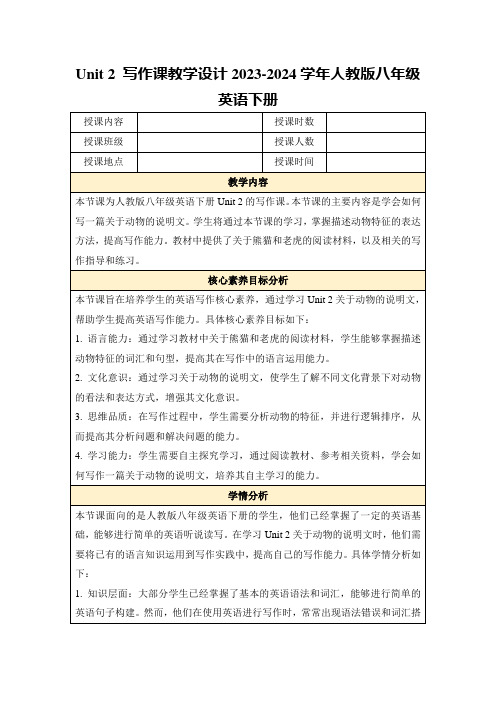
2.能力层面:学生的阅读理解能力较好,能够理解教材中关于熊猫和老虎的阅读材料。但在写作过程中,他们往往难以将自己的想法准确地用英语表达出来。此外,学生的写作能力参差不齐,部分学生写作兴趣不高,写作内容贫乏,缺乏逻辑性和连贯性。
6.自我评估和反思:学生应具备自我评估和反思的能力,能够对自己的写作过程和成果进行评估,发现自身的优势和不足,并在此基础上进行改进和提高。
教学反思与改进
在教授Unit 2写作课的过程中,我观察到学生们对于动物特征的描述方法有一定的掌握,但在写作结构的设计和写作技巧的运用上还存在一些问题。此外,学生在合作学习和交流方面也有待提高。以下是我对教学过程的一些反思和改进措施:
2.辅助材料:为了丰富教学内容和提高学生的学习兴趣,准备与本节课主题相关的图片、图表、视频等多媒体资源。例如,关于熊猫和老虎的图片、图表,以及相关的英语动画视频。
3.实验器材:本节课不涉及实验操作,但如果有实验环节,需要提前准备实验器材,并确保其完整性和安全性。
4.教室布置:根据教学需要,对教室进行布置。将教室分为若干个小组讨论区,每个区域配备相应的桌椅,以便学生进行小组讨论和合作学习。同时,设置一个实验操作台,用于展示实验过程和结果。
针对以上学情分析,教师在教学过程中应注重激发学生的学习兴趣,鼓励他们积极参与课堂活动。同时,教师应针对学生的知识水平和能力层次,设计具有针对性的教学内容和活动,帮助他们克服写作困难,提高写作能力。在教学过程中,教师还应关注学生的心理素质和行为习惯,引导他们培养良好的学习习惯和合作意识。
高教版基础英语第二册教案——Unit2DescribingPeople

Unit 2 Describing PeopleThe First PeriodTeaching aims:1.To talk about people’s appearance, dressing, characters and jobs,etc.2.To learn the words and expressions used to describe.3.To be able to describe the people that you’re familiar with.4.Master the important phrases.Key points:To learn how to describe people.Difficult points:Who is the gentleman with…?Doesn’t he look…?She looks so…in her...…is my favorite actor.Teaching Methods:1. Watching and saying2. Pair work and group workTeaching aids:tape recorderProcedures:Step 1 Greetings and Lead-inGreet the whole class.Ask Ss to do Warm-up.1.Ask Ss to describe what their classmates look like, from hair to noses, faces, eyes,mouths,etc. Pracitise the words used to name the organs on the face.2.Learn to describe Mona Lisa.3.Know more about Mona Lisa on Page.28, Culture Notes.Step 2 Listening 11.Learn the new words of this part.Notes:oval adj.椭圆的blonde adj. 金发白肤的n. 金发女郎curly adj. 卷曲的;卷发的brown adj. 褐色的;棕色的n. 褐色lawyer / n. 律师two-piece adj. & n. 由两件组成一套的(衣服)yellow n.& adj.黄色(的)suit n.套装grandpa n.爷爷2. Ask Ss to look at the pictures, and then prepare doing listening.3. Play the tape. Ask Ss to do the match.4.Play the tape again, and then check the answers with the whole class.Script of listening:1. Richard Clayderman has got light brown hair.2. Celine Dion has got dark brown hair.3. Liu Huan has got straight black hair.4. Madonna has got curly blond hair.Step 3 Dialogue 11.Explain some important words and useful sentences. Encourage Ss to make somesentences.2.Explain the important phrases and divide the students into 3 groups to discuss andcomplete the dialogue with the words given below.3.Play the tape and ask Ss to read after it, and then ask Ss to play the dialogue.4.Let Ss to guess where the dialogue takes place and the relation between them.Ask Ss to talk about the words about clothing, like coat, suit, dress, jacket, tie, shirt, trousers, jeans, skirt, etc.5.Remember the following important phrases:Who is the gentleman with…?Doesn’t he look…?She looks so…in her...…is my favorite actor.Step 4 Role Play 11.Practise the important phrases and words.2.Ask Ss to practise the dialogue as Dialogue 1. Ask some Ss to play the dialogue infront of the class.3.Ask Ss to practise more about this pattern.Step 5 Homework1.Make a dialogue in pairs with the knowledge learnt today.2.Copy the new words three times.3.Recite the dialogue 1 on page19.The Second Period Teaching aims:1.To learn how to describe the people Ss are familiar with.2.To complete the dialogue with the words given in the box.3.To master some words and phrases.Key points:How to talk about people’s appearance, weight, height, etc. Difficult points:You know…,don’t you?He’s the first Chinese man in…He’s in his early 40s.He’s of medium height.I wish I could…Teaching Methods:1. Watching and saying2. Pair work and group workTeaching aids:tape recorderProcedures:Step 1 Greetings and Lead-inGreet the whole class.Review the important phrases learned last period.Step 2 Listening 21.Learn the new words of this part.Notes:glasses n.眼镜height n.高度astronaut n.宇航员;太空人someday adv.(将来)有一天middle-aged adj.中年的medium-sized adj.中型的,中号的2.Ask Ss to look at the pictures, and ask them to say who they are in English.3.Play the tape, and ask Ss to do the match.4.Play the tape again, and then check the answers with the whole class.Script of listening:1. Jack Welch became the CEO of GE very early.2. Charles Wang founded CA.3. Donald Trump became interested in real estate very early.4. Joyce Hall founded the Hallmark Cards Company.Step 3 Dialogue 21.Explain some important words and useful sentences. Encourage Ss to make somesentences.2.Practise how to fill the blanks correctly, introduce more words about Yang Liwei,like astronaut, pilot, airplane,etc.3.Play the tape and Ss read after it. Then ask some Ss to play the dialogue.4.Remember the following important phrases:You know…,don’t you?He’s the first Chinese man in…He’s in his early 40s.He’s of medium height.I wish I could…Step 4 Role Play 21.Practise the important phrases and words.2.Ask Ss to practise the dialogue as Dialogue 2.3.Master how to talk about people’s appearance, weight, height, etc.Step 5 Homework1.Make a dialogue in pairs with the knowledge learnt today.2.Copy the new words three times.3.Recite the dialogue on page 21.The Third PeriodTeaching aims:1.To learn how to talk about the characters of the teachers and relatives2.To do some listening and learn the words about occupatations.3.To master some words and phrases.Key points:Talk about the teachers’ features.Difficult points:What do you think of…?How about…?What makes her such a nice teacher?She’s very…You won’t be sorry.Teaching Methods:1. Watching and saying2. Pair work and group workTeaching aids:tape recorderProcedures:Step 1 Greetings and Lead-inGreet the whole class.Review the important phrases learned last period.Step 2 Listening 31.Learn the new words of this part.Notes:estate n.不动产;财产developer n.开发者;启发者founder n.创办人boring adj. 令人厌烦的,单调沉闷的asleep adj.睡着的hardworking adj.苦干的,不辞辛劳的real estate 房地产;不动产fall asleep 入睡;长眠get into 参加;加入2.Ask Ss to look at the words, and ask them to guess what they are going to listen.3.Play the tape, and ask Ss to match the answers.4.Play the tape again, and then check the answers with the whole class.Script of Listening 31. Jack Welch became the CEO of GE very early.2. Charles Wang founded CA.3. Donald Trump became interested in real estate very early.4. Joyce Hall founded the Hallmark Cards Company.Step 3 Dialogue 31.Explain some important words and useful sentences. Encourage Ss to make somesentences.2.Have the students work in groups and fill in the blanks with the words given.3.Play the tape and Ss read after it. Then ask some Ss to play the dialogue.4.Let Ss to guess where the dialogue takes place and what relation between them.5.Remember the following important phrases:What do you think of…?How about…?What makes her such a nice teacher?She’s very…You won’t be sorry.Step 4 Role Play 31.Explain the important words and phrases, and then practise them.2.Ask Ss to practise the dialogue as Dialogue3.3.Ask Ss to make a dialogue to talk about what their teachers look like.Step 5 Homework1.Make a dialogue in pairs with the knowledge learnt today.2.Copy the new words three times.3.Recite the dialogue on page 22.The Fourth PeriodTeaching aims:1.To talk about their favorite musicians.2.To talk about what’s needed to be a qualified musician.3.To master some words and phrases.Key points:Talk something about the muisiciansDifficult points:At the age ofBe attended toTake part inTeaching Methods:1. Watching and saying2. Pair work and group workTeaching aids:tape recorderProcedures:Step 1 Greetings and Lead-inGreet the whole class.Review the dialogue 3 learned last period.Step 2 Pre-reading Activities1.Learn the new words of this part.Notes:academy n. (高等)专科院校,研究院prize n. 奖赏;奖金;奖品medal n. 奖章,勋章;纪念章reporter n. 记者at the age of 在…岁时be attached to 附属于…take part in 参与,参加2.Ask Ss to talk about their favorite musicians with their partners, prepare someuseful words like classical music, light music, pop music, rock music, etc.3.Introduce some famous pianists, like Beethoven, Bach, Tchaikovsky, RichardClayderman.Step 3 Text1.Explain some important words and useful sentences. Encourage Ss to make somesentences.2.Play the tape and Ss read after it. Then ask some Ss to read the text.3.Ask Ss to finish the comprehension exercises, then check answers with the wholeclass, and ask Ss to correct the sentences.4.Grammar: This apart is about Attributive Clause. Ask Ss to find the relatedsentences from the text.5.Culture Notes◊Mona Lisa文艺复兴时期的艺术巨匠达•芬奇的名画《蒙娜丽莎》◊Modonna 美国当代著名歌星麦当娜◊Celine Dion 加拿大著名歌星席琳•迪翁◊Richard Clayderman 当代法国著名钢琴家理查德•克莱德曼◊Michael Jordan 美国著名篮球巨星迈克尔•乔丹,素有“空中飞人”之称。
《英语写作 II 》-课程教学大纲
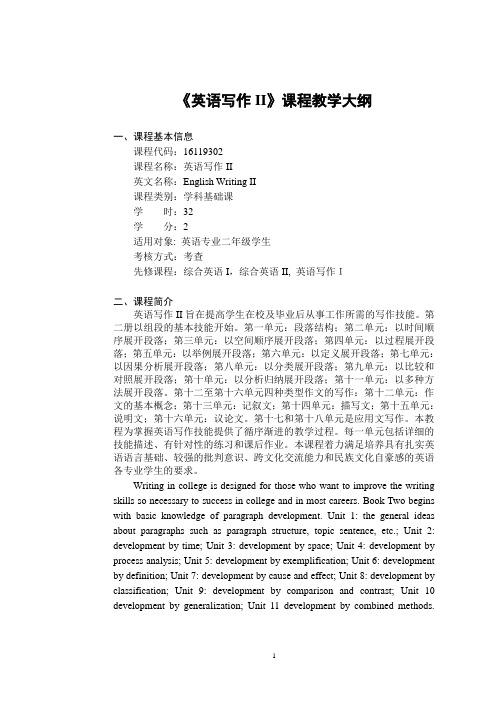
《英语写作II》课程教学大纲一、课程基本信息课程代码:16119302课程名称:英语写作II英文名称:English Writing II课程类别:学科基础课学时:32学分:2适用对象: 英语专业二年级学生考核方式:考查先修课程:综合英语I,综合英语II, 英语写作I二、课程简介英语写作II旨在提高学生在校及毕业后从事工作所需的写作技能。
第二册以组段的基本技能开始。
第一单元:段落结构;第二单元:以时间顺序展开段落;第三单元:以空间顺序展开段落;第四单元:以过程展开段落;第五单元:以举例展开段落;第六单元:以定义展开段落;第七单元:以因果分析展开段落;第八单元:以分类展开段落;第九单元:以比较和对照展开段落;第十单元:以分析归纳展开段落;第十一单元:以多种方法展开段落。
第十二至第十六单元四种类型作文的写作:第十二单元:作文的基本概念;第十三单元:记叙文;第十四单元:描写文;第十五单元:说明文;第十六单元:议论文。
第十七和第十八单元是应用文写作。
本教程为掌握英语写作技能提供了循序渐进的教学过程。
每一单元包括详细的技能描述、有针对性的练习和课后作业。
本课程着力满足培养具有扎实英语语言基础、较强的批判意识、跨文化交流能力和民族文化自豪感的英语各专业学生的要求。
Writing in college is designed for those who want to improve the writing skills so necessary to success in college and in most careers. Book Two begins with basic knowledge of paragraph development. Unit 1: the general ideas about paragraphs such as paragraph structure, topic sentence, etc.; Unit 2: development by time; Unit 3: development by space; Unit 4: development by process analysis; Unit 5: development by exemplification; Unit 6: development by definition; Unit 7: development by cause and effect; Unit 8: development by classification; Unit 9: development by comparison and contrast; Unit 10 development by generalization; Unit 11 development by combined methods.From Unit 12 to Unit 16, the techniques of paragraph writing are applied step by step to the process of the four types of composition writing: description, narration, exposition and argumentation. Unit 12: the general ideas about composition; Unit 13: narration; Unit14: description; Unit15: exposition; Unit16: argumentation. Unit17 and Unit18 tell students how to write different practical requirements that are most commonly used in college and in society. The book is a step-by-step process teaching skills basic to writing in the English language. Each unit includes detailed descriptions of skills involved as well as examples and exercises to practice the skills. Its clear, paced lessons, plentiful practices, and engaging writing assignments guide students through the process of writing effective paragraph and essays, from prewriting to final draft, and it will provide students with clear insight into the English composition. The course aims at educating students majoring in English to understand and use English well, to think critically, to perform actively in transcultural communication, and to be proud of Chinese culture.三、课程性质与教学目的写作是英语专业的重要专业课程之一。
英语试题练习题教案学案课件英语写作(二)课程教学大纲.doc
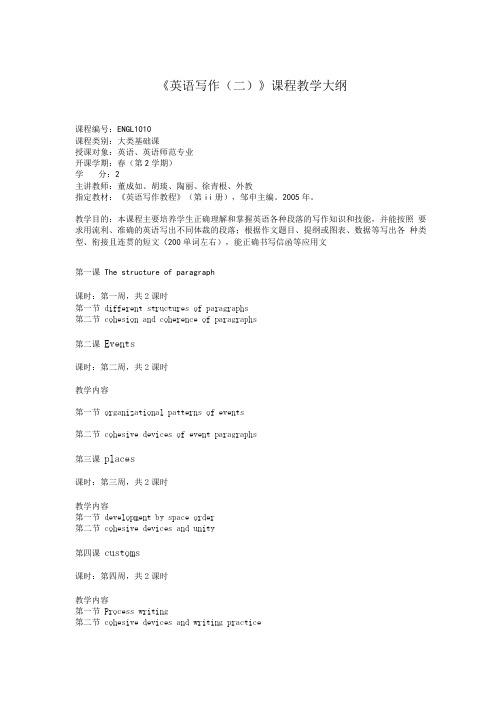
《英语写作(二)》课程教学大纲课程编号:ENGL1010课程类别:大类基础课授课对象:英语、英语师范专业开课学期:春(第2学期)学分:2主讲教师:董成如、胡琰、陶丽、徐青根、外教指定教材:《英语写作教程》(第ii册),邹申主编。
2005年。
教学目的:本课程主要培养学生正确理解和掌握英语各种段落的写作知识和技能,并能按照要求用流利、准确的英语写出不同体裁的段落;根据作文题目、提纲或图表、数据等写出各种类型、衔接且连贯的短文(200单词左右),能正确书写信函等应用文第一课The structure of paragraph课时:第一周,共2课时第一节different structures of paragraphs第二节cohesion and coherence of paragraphs第二课Events课时:第二周,共2课时教学内容第一节organizational patterns of events第二节cohesive devices of event paragraphs第三课places课时:第三周,共2课时教学内容第一节development by space order第二节cohesive devices and unity第四课customs课时:第四周,共2课时教学内容第一节Process writing第二节cohesive devices and writing practice第五课Career课时:第五周,共2课时教学内容第一节ExempIi f i cat i on第二节Choosing the right examples第六课Nature and thought课时:第六周,共2课时教学内容第一节Definition第二节organizational patterns of definition第七课Social problem课时:第七周,共2课时lems教学内容第——节Cause end effect analysis第二节Organization of cause and effect writing第八课Education课时:第八周,共2课时教学内容第一节Features of classification writing第二节Organization of classification writing第九课Culture课时:第九周,共2课时教学内容第一节Features of compar i son and contrast第二节Organization of comparison and contrast writing 第十课Mass med i a课时:第十周,共2课时教学内容第一节Generalization writing第二节Cohesion and coherence in generalization writing 第--- 课People课时:第十一周,共2课时教学内容第一节Combined methods第二节Organization patterns of paragraphs 第十二课Compos it i on writing课时:第十二周,共2课时教学内容第一节General introduction第二节Cohesion and coherence in composition 第十三课Memories课时:第十三周,共2课时教学内容第一节Narration writing第二节Prganization of narratives第十四课Life课时:第十四周,共2课时教学内容第一节Description writing第二节Cohesion and coherence in description 第十五课Science课时:第十五周,共2课时教学内容第一节Exposition writing第二节Cohesion and coherence in exposition 第十六课Fitness and health课时:第十六周,共2课时教学内容第一节Argumentation writing第二节Organization of argumentation writing 第十七课Letters课时:第十七周,共2课时教学内容第一节Format of letters第二节Styles of letters第十八课Notes, cards and notices课时:第十八周,共2课时教学内容1、2、第一节Formats of notes, cards and notices第二节Styles of notes, cards and notices第十九课Rev i ew and d i scus i on第二十周Term examination参考书目:丁往道:《英语写作手册》(第二版)。
英语写作教程2教案
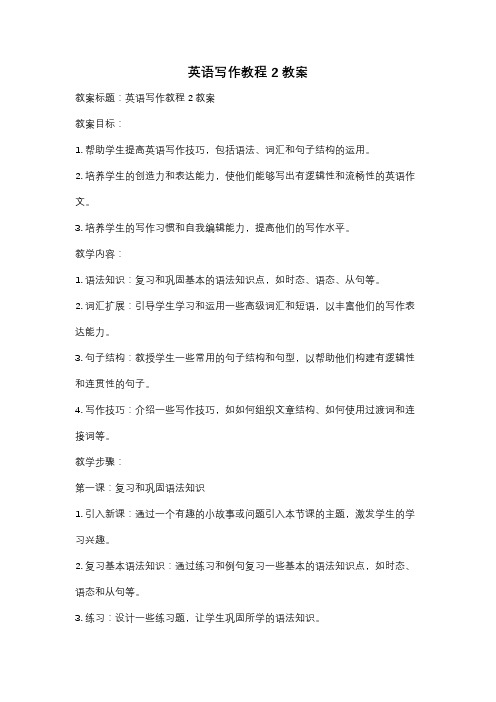
英语写作教程2教案教案标题:英语写作教程2教案教案目标:1. 帮助学生提高英语写作技巧,包括语法、词汇和句子结构的运用。
2. 培养学生的创造力和表达能力,使他们能够写出有逻辑性和流畅性的英语作文。
3. 培养学生的写作习惯和自我编辑能力,提高他们的写作水平。
教学内容:1. 语法知识:复习和巩固基本的语法知识点,如时态、语态、从句等。
2. 词汇扩展:引导学生学习和运用一些高级词汇和短语,以丰富他们的写作表达能力。
3. 句子结构:教授学生一些常用的句子结构和句型,以帮助他们构建有逻辑性和连贯性的句子。
4. 写作技巧:介绍一些写作技巧,如如何组织文章结构、如何使用过渡词和连接词等。
教学步骤:第一课:复习和巩固语法知识1. 引入新课:通过一个有趣的小故事或问题引入本节课的主题,激发学生的学习兴趣。
2. 复习基本语法知识:通过练习和例句复习一些基本的语法知识点,如时态、语态和从句等。
3. 练习:设计一些练习题,让学生巩固所学的语法知识。
第二课:词汇扩展和句子结构1. 引入新课:通过展示一些高级词汇和短语的例句,引导学生学习和运用这些词汇。
2. 学习高级词汇和短语:逐个介绍一些高级词汇和短语,并提供相关的例句和练习。
3. 句子结构练习:通过给学生一些句子结构的例子,让他们进行仿写和创作,以提高他们的句子表达能力。
第三课:写作技巧和实践1. 引入新课:介绍一些写作技巧,如如何组织文章结构、如何使用过渡词和连接词等。
2. 练习写作:给学生一个写作任务,让他们根据所学的写作技巧和知识进行写作练习。
3. 互相编辑和反馈:学生互相交换作文,进行编辑和反馈,帮助他们改进写作。
第四课:总结和评估1. 总结所学知识:复习本单元所学的语法知识、词汇和句子结构,并进行小结和总结。
2. 评估学生写作水平:给学生一个写作任务,评估他们在本单元所学的知识和技巧的运用情况。
3. 反馈和建议:根据学生的表现,给予他们反馈和建议,帮助他们进一步提高写作水平。
《英语写作2》教学大纲--定稿1

《英语写作2》教学大纲课程编号:英文名称:College English Composition II学分:2 学时:32修课程:英语写作I 、英语阅读、综合英语适用专业:英语专业教学目的:在巩固段落写作技巧、篇章布局和短文写作的基础上,进一步训练学生掌握各种文体及篇章结构的特点。
培养学生欣赏佳作和自我修改的能力。
能写各类体裁的文章,做到内容充实,语言通顺,用词恰当,表达得体。
通过内容题材过程写作培养学生的创造性思维、逻辑性思维和评判思维能力;巩固和锤炼各种写作技巧,如分析、分类、比较、形成假设、进行证明和做出结论的能力。
具体要求写作专业学习所必需的议论文、学术论文或科研报告等。
也为巩固和深入理解和欣赏阅读课、文学课和其他课程的学习内容服务,即以写促学。
教学要求:1)广泛而大量的阅读,并根据课堂讲授的方法长期写作有明确中心和充分论据的读书笔记2)积极参加课堂、课外小组讨论、互改练习3)细读文本,查找相关资料,深入探讨某个课题。
教学内容:第一部分写作方法、理论和任务共2学时Lecture 1 Course Orientation ----Learning (pp1-5 )about learning to writeOverview the project1 Reading and writing theory: Book three: pp68-76 , Teaching ESL composition2. Preparing for a term paper/Towards academic writing3. Developing an argument/Topics for TEM-8 writings ( Book 3:pp1-78)4. Practical writing5. One theme, different styles重点:英文写作元认知调查, 介绍课本(《大学英语写作》第三册)及高级英语读写材料主要内容、布置本学期课外学习的任务;明确教学方法: 在授课中贯彻学生为中心的教学方法:学生写作读书笔记,配合课堂理论教学,小组讨论并检查; 过程写作方法简单介绍难点:分析自身问题的认知根源,提出教与学的内容与方法第二部分议论文写作4 学时Lectures 2&3Handouts: Key features of argumentative writings ( Qi Shou-hua: 386-394;Ding Yen-ren : 1-78); Making arguments (Gu Yue-guo: 339-351); TEM-8 topics, samples and the latest issues 重点:能够在规定时间内写作400字的议论文,要求有做到内容充实,语言通顺,用词恰当,表达得体. Understanding key features of argumentative writings 难点:提高欣赏、鉴别好文章(议论文)之能力,提高写作能力What is a good argument and how to improve writing skills说明;学生学习了议论文写作方法之后,教师指定或自选题目平时坚持自我训练,学期中穿插课堂检查。
- 1、下载文档前请自行甄别文档内容的完整性,平台不提供额外的编辑、内容补充、找答案等附加服务。
- 2、"仅部分预览"的文档,不可在线预览部分如存在完整性等问题,可反馈申请退款(可完整预览的文档不适用该条件!)。
- 3、如文档侵犯您的权益,请联系客服反馈,我们会尽快为您处理(人工客服工作时间:9:00-18:30)。
Essential elements of narration
A series of events Told by a narrator For some particular purpose
Activity 1
Check the sentences that you think would make interesting topic sentences for personal experience narrative. And explaive
A narrative is a story developed from an event or a series of events Character, setting and the mood are usually established at the beginning of the story The middle describes events in which a character deals with some kind of conflict The end of the story or climax, tells how the conflict is resolved
What Narrative Writing Is and Is Not
An effective narrative composition . . . Tells a personal or imaginative story May include the writer’s imagination and personal experiences that are related to the story Contains narrative elements such as characters, plot, point of view, setting, conflict, and/or significant events Contains narrative strategies such as, flashback, foreshadowing, dialogue, tension and/or suspense Is multi-paragraph Presents a story that has a well-developed beginning, middle, and end An effective narrative composition is NOT . . . A list of events and/or facts An abundance of facts or personal anecdotes that are unrelated to the topic A list of reasons, opinions, or unrelated episodes
Activity:
Compare two passages by your peers (p.8,p.9) “Reunion with my best friend” “what a change” Which one is better? (Title, topic, structure, content, writing skill, language…)
An effective narrative composition . . . Uses a lively writing voice to engage the reader Uses vivid sensory details and concrete language An effective narrative composition is NOT . . . Flat, uninteresting writing A story that contains imprecise language
Narration
Types Elements Tips on writing personal narratives
Narration and its types
It is the type of writing which tells a story: personal experience imaginative fiction, or historical narrative ( a story or an account of something that happened).
Report
Descriptive
Factual procedures Account
Poetry
Even within each genre of writing there are different kinds of writing
Narrative
Anecdote
Biography
Stories with a plot
Fables and Legends
Autobiography
Narrative Poem
Each “kind” ( or genre) of writing has certain characteristics Narrative
Has a plot- beginning middle end Has interesting characters Has an interesting setting (place, time)
Formulaic, repetitive writing
A single paragraph A paper that lacks a clear beginning, middle, and end
Genres: Narrative Writing
39
What Narrative Writing Is and Is Not
Uses a variety of sentences Contains correct sentences, usage, grammar, and spelling that make the writer's ideas understandable
A story with little sentence variety Incorrect sentences, usage, grammar, and spelling that prevent the reader from understanding the writer's ideas
Narrative writing appears in and is not limited to novels, short stories, biographies, autobiographies, historical accounts, essays, poems, and plays.
Genres: Narrative Writing
40
Personal experience narrative
Narrator: first person Structure: 1.begining: topic sentence ( who, when, where, what, why, how..), describing the whole event (p.2) 2. body: present the experience in chronological order ( using some transitions: afterward, later, when, soon, while, before, then….) (p.5) 3. end: summarize the whole text and show the theme (p.3 reading)
Memorable significant moments
(period 2)
Warm up
Is there any significant moment in your life? Try to share it with us.
In order for the following to make sense, you need to understand the difference between a phrase and a clause (dependent or independent). A phrase is a group of words that does not express a complete thought. It might have a subject or a verb, but it does not have both. As a result, the phrase does not make sense standing by itself: Waiting at the street corner Tired from working all day This morning at school
Good Narration: Includes specific details to make the incident come alive for your reader Focuses on re-creating an incident that happened to you over a short period of time (usually an emotional experience) Conveys a particular mood (feeling) - do you want to surprise your readers, make them laugh, have them share in your sorrow or fear?
Writing
List all the ideas of reunion you have experienced. Make a plan Discuss with your classmates write according to your plan improved Editing
